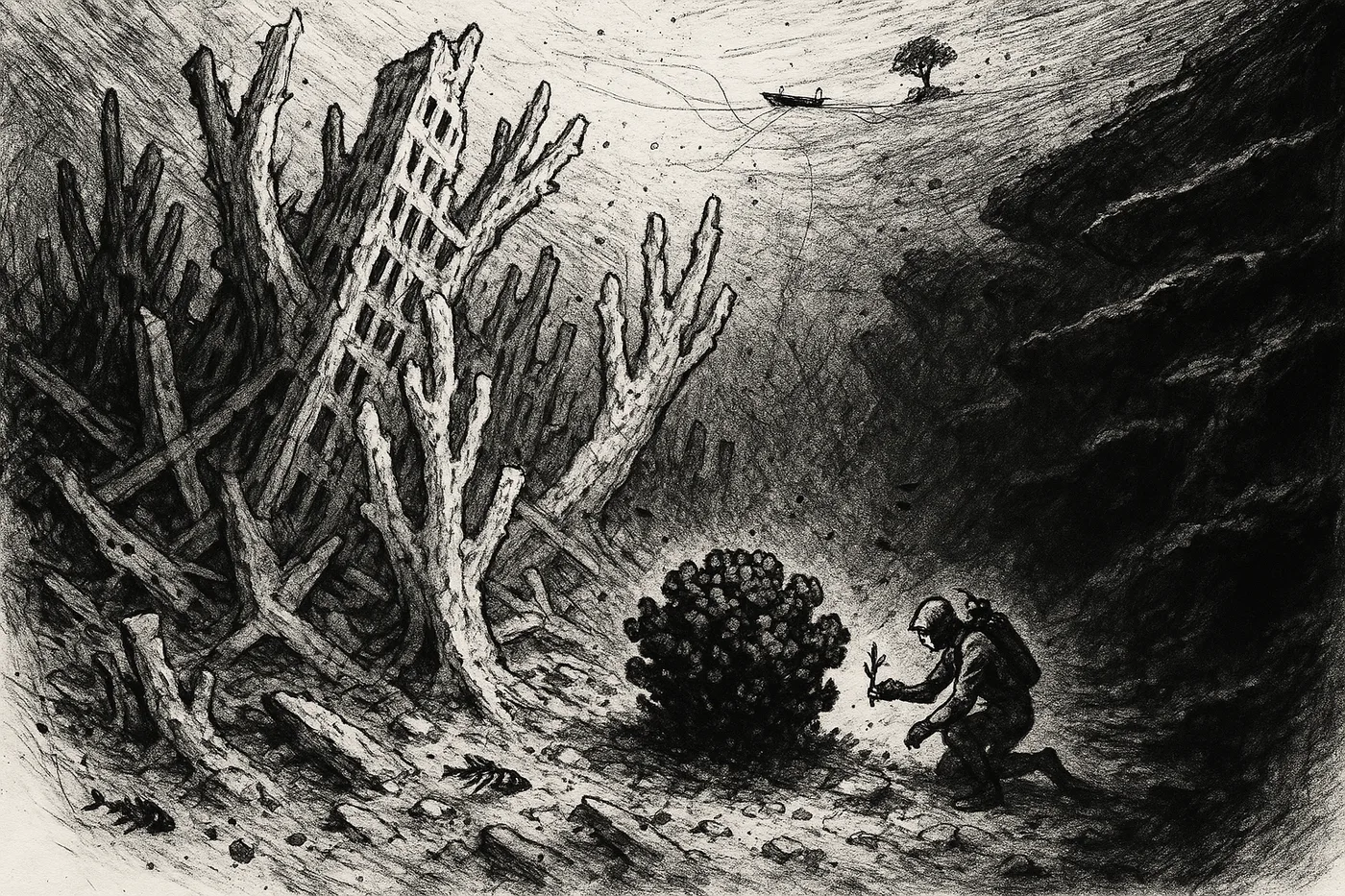TLDR: Coral reefs have already passed their climate tipping point at 1.4°C warming, with 84% of global reefs experiencing bleaching-level heat stress between 2023-2025—the most intense global event ever recorded. While large-scale recovery is unlikely, scientists are discovering resilient deep-water refuges, developing heat-tolerant coral nurseries, and identifying molecular markers that predict survival, offering fragmented hope for maintaining ecosystem services that sustain nearly a billion people.
Wait, what? At just 1.4°C of global warming, warm-water coral reefs have officially crossed their climate tipping point. Not "might cross" or "approaching"—crossed. The 2025 Global Tipping Points Report, authored by 160 scientists from 23 countries, confirms that between January 2023 and March 2025, 84% of the world's reefs endured bleaching-level heat stress. The most intense global event ever recorded.
Yet here's the twist: while underwater metropolises turn to ghostly rubble, unexpected pockets are holding strong. Scientists are mapping resilient refuges and unlocking coral superpowers we didn't know existed. This isn't another elegy for a dying ecosystem. It's a story about planetary interconnections we've ignored and the human creativity we're finally unleashing when the stakes get real.
The Math Behind the Meltdown
Coral reefs run on a partnership. Tiny polyps host colorful algae called zooxanthellae, which photosynthesize sunlight into food. When ocean temperatures spike—even 1°C above normal for a few weeks—corals evict their algae. Without that fuel source, they starve. Turn white. Die if the heat persists.
This is bleaching, and it's accelerating. Live coral cover has plummeted 50% since the 1950s, with a 14% loss between 2009 and 2018 alone. The Great Barrier Reef? Hit by consecutive mass bleaching events that shredded recovery time. The Caribbean, Indian Ocean, Pacific atolls—all cooking.
Scientists pegged the thermal threshold at around 1.2°C of global warming. We're now at 1.4°C. The 2023-2025 event torched reefs in 82 countries. Even if we stabilize at 1.5°C—the Paris Agreement's stretch goal—there's a 99% probability reefs will tip into degraded, algae-dominated wastelands.
The window for business-as-usual closed before most people realized it was open.
The Planet's Hidden Wiring
Here's where reef collapse stops being just an ocean problem. These ecosystems anchor the lives of nearly a billion people through fishing, tourism, and coastal protection. They host 25% of all marine species despite covering less than 1% of the ocean floor.
Lose them, and the ripples spread like cracks in ice. The 2025 report, led by the University of Exeter and Stockholm Resilience Centre, maps these cascades: Reef degradation collapses small-scale fisheries, triggering economic tipping points in coastal communities. Dead reefs stop buffering storm surges, exposing shorelines to erosion and flooding. Ocean chemistry shifts as algae blooms replace coral, stratifying waters and amplifying warming feedbacks.
Then the dominoes fall across Earth systems. The Atlantic Meridional Overturning Circulation—the current that keeps Europe warm—slows under disrupted salinity patterns, potentially plunging northwest Europe into severe winters. Amazon forests, already stressed by deforestation and drought, inch closer to savannization. Ice sheets in Greenland and West Antarctica, their tipping points hovering around 1.5°C, lock in meters of sea-level rise over centuries.
It's not hype. It's the physics of interconnection. Pull one thread—coral reefs, say—and watch the whole planetary fabric strain.
Where Science Gets Creative
But understanding these connections reveals intervention points. Human ingenuity, it turns out, thrives when pushed.
Mesophotic coral ecosystems—reefs lurking between 30 and 150 meters deep—largely dodged the 2023 Caribbean bleaching. Cooler waters at depth act as thermal refuges, preserving genetic diversity that could reseed shallow reefs if conditions improve. They're underwater bunkers for biodiversity.
On land, integrated management works. Twenty years of data from Hawai'i show that cutting wastewater pollution and overfishing together boost reef resilience by 20-50%. Not one or the other—both. It mirrors what Indigenous communities in the Pacific have practiced for generations: treating land and sea as one system.
Restoration is scaling up. Florida and Indonesia are pioneering coral nurseries that propagate heat-tolerant species and outplant them onto degraded reefs. Some sites regain structural complexity in 3-4 years. Not a full recovery, but enough to maintain ecosystem services in fragmented patches.
Then there's the molecular detective work. Researchers studying Montipora capitata, a Hawaiian coral, identified protein signatures that predict survival. Resilient corals stockpile proteins for nutrient uptake, antiviral defense, and—crucially—retaining their algae partners under stress. This isn't just academic curiosity; it's a breeding blueprint for super-corals engineered to withstand the heat.
The International Coral Reef Initiative is pushing for sevenfold increases in restoration funding. At COP30, negotiators are weighing mandates for clean energy transitions that could stabilize warming below catastrophic thresholds. Indigenous-led governance models are gaining traction, blending traditional ecological knowledge with cutting-edge science.
Every local action—removing a pollutant source, protecting a fish nursery, planting heat-resistant coral—buys fragments of reef a fighting chance.
The Unexpected Upside of Understanding Doom
The 2025 Global Tipping Points Report doesn't sugarcoat the loss. Large-scale reef recovery at current warming levels is unlikely. The reefs we knew are vanishing.
Yet the report also crystallizes what we're fighting for: not restoring a static past, but preserving functional pockets that sustain biodiversity and livelihoods while we slash emissions fast enough to drop warming back toward 1°C. It's the difference between total ecosystem collapse and fragmented resilience that keeps half a billion people fed and millions of species alive.
That shift in framing matters. We're not powerless spectators watching tragedy unfold. We're scientists mapping thermal refuges, communities cutting pollution, policymakers redirecting billions toward restoration, and geneticists breeding corals that can take the heat.
Coral reefs crossed a tipping point, yes. But so can we—toward the kind of systemic, creative response that actually matches the scale of the crisis. The first domino has fallen. What we do with the rest of them is still being written.

